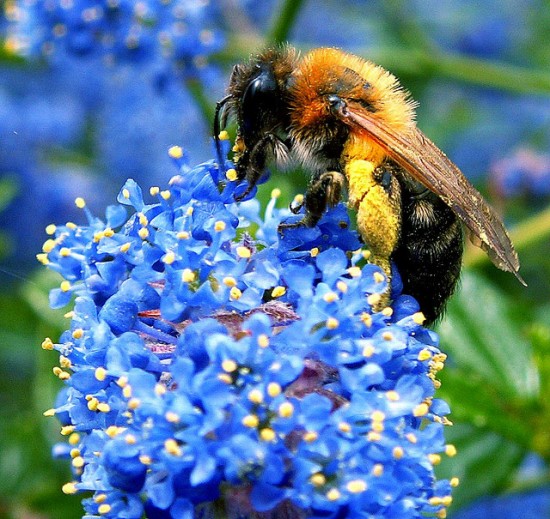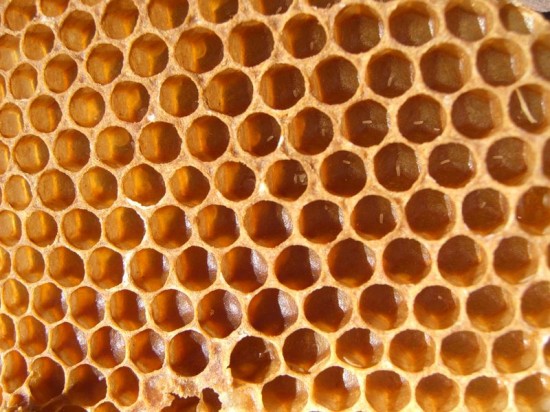Pam’s next step for personal resilience: bringing a wild beehive home.
By Pamela O’Malley Chang
The bees were where we were told they would be—10 feet up in a tree overhanging the sidewalk in a residential neighborhood of Oakland, Calif.
Also as told, there were a couple of plate-sized pieces of honeycomb on the sidewalk where they’d fallen from strong winds two days previously. These were creamy white, redolent with honey, with a few stray bees on top. Beekeeper Joan Weir examined the honeycomb, showing me which of the capped cells contained bee brood—that is, eggs and larvae—and which contained pollen or honey. We put the fallen combs into the large cardboard box we’d brought. Joan went in search of neighbors and ladders and planned her strategy while I contemplated “my” bees, the bees we would put in the hive that we’d set up in my backyard earlier that afternoon.
I’ve been interested in keeping bees for at least a couple of decades, probably since reading Sue Hubbell’s A Book of Bees. Hubbell, once a New York librarian, had moved to the Ozarks and taken up beekeeping as a livelihood. She wrote lyrically of the yearly rhythm of beekeeping, and the keen observation of bee behavior and of flowers in bloom that the bees inspired. Or perhaps, my interest began in my childhood when I visited an agricultural show and saw the inside of a beehive through a glass window.
Over the years, I’d been to a couple workshops on beekeeping but so far, I’d felt too busy to start a new hobby. This fall, however, at yet another beekeeping class, I’d learned that Joan Weir had a beehive to sell. Oddly enough, though, I couldn’t buy Joan’s hive. She and I live only a mile apart; bees have a 2-5 mile range. If they are moved within their range, they know all the landmarks and will fly back to their old homestead. But Joan had just been called to collect a hive in Oakland, some dozen miles from my home, so here we were.
By now, Joan had put on her bee suit and climbed an extension ladder to reach the branch from which the beehive hung. I stood on a stepladder below her, holding the box with the two broken pieces of comb above my head. Joan cut the branch with a pruning saw and placed the branch, nest and all, into the box.
Suddenly the box buzzed, both audibly and through my fingers. With the help of the neighbors, I descended the ladder and we put the box on the sidewalk. After observing the bees for a while, Joan assured us that their stance—face in and tail out—meant that we had captured the queen. Joan also explained to us that, because stinging is suicidal to worker bees (unlike queen bees or hornets and wasps), honeybees tend to be non-aggressive, attacking only when their hive is directly threatened. She instructed us to avoid sudden movements and to back up slowly if the bees came at us.
We watched the bees and their box on the sidewalk for about an hour. At one point, many of the bees emerged from the box and we worried that they would swarm. Joan gently swept those on top of the box inside using a brush with long soft bristles. Then she taped three of the four box flaps shut and we waited again for the bees to settle. Most stayed in the box. Some clustered in a fist-sized clump in the tree next to their former home. Finally Joan punched several small air holes in the side of the box, swept in the last of the bees and taped up the last of the edges. We wrapped the box in a large drawstring net, put it on the backseat of the car, put the tools away, and headed home.
In my backyard, Joan transferred the bees and their nest to my new hive, taking out several vertical frames to allow space for the wild nest. Four days later, Joan brought the rest of the colony, the straggler bees that had stayed in their home tree. Next week, three weeks from their original transplant date, Joan and I will open the new hive. To help them through the winter, we’ll give my bees a frame of honey and a frame of brood from one of Joan’s established hives.
eanwhile I visit the bees a few times a day when I am home. Early in the morning, just a few of them will be setting out. At noon, they’ll be coming and going like rush hour traffic. In the evening, a few will be coming home. At night, they stay inside. If I lean down with my ear close to the hive, I can hear them buzzing. They sound angry, but I know it is only the sound of 20,000 or so critters fanning their wings.
I hope they’ll do well in my backyard. Right now, there are pink jasmine flowers in bloom for them and soon they’ll have lemon and orange blossoms. I don’t know what else they’ll eat, but I’m betting that there are enough blooming urban flower gardens in my neighborhood to keep them happy. In the spring, they’ll help pollinate my apple trees and garden vegetables. By next fall, they may or may not have produced enough extra honey to share some with me. Either way, I’m happy to have them buzzing around, making my world bigger by bringing me knowledge of their minute but intimately detailed world.
Photo Credits
“Pollinated! Honey Bee on Ceanothus.” Durotriges @ Flickr.com. Creative Commons. Some Rights Reserved.
“Babees (or bee eggs)” willsfca @ Flickr.com. Creative commons. Some Rights Reserved.
Pamela O’Malley Chang wrote this article for YES! Magazine, a national, nonprofit media organization that fuses powerful actions, as part of a series of articles on Transition Towns as seen from Albany, CA. Pamela is co-owner of Sarana Community Acupuncture and is a contributing editor to YES! Magazine.
_______________________________________________________________________________________________________________________________________________________________
YES! Magazine encourages you to make free use of this article by taking these easy steps.

Recent Guest Author Articles:
- How Strong Business Training Translates Into Everyday Decision-Making
- New Career and Degree Paths for Educators Who Want to Make a Broader Impact
- Finding the Right Plumber in Portland: A Comprehensive Guide for Homeowners
- Why Choose Elara Caring for Jackson, MI Home Health Services?
- How I Turned Poetry into a Paycheck




[…] This post was mentioned on Twitter by Dan L Hays and christopherholt, Life As A Human. Life As A Human said: New Article, Bees for My Backyard – http://tinyurl.com/2bao9s9 […]